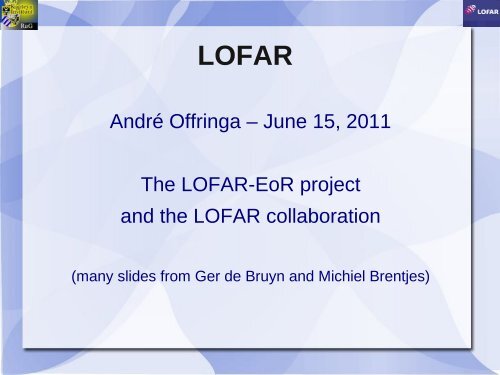A.R. Offringa - LOFAR - CHIME
A.R. Offringa - LOFAR - CHIME
A.R. Offringa - LOFAR - CHIME
Create successful ePaper yourself
Turn your PDF publications into a flip-book with our unique Google optimized e-Paper software.
<strong>LOFAR</strong><br />
André <strong>Offringa</strong> – June 15, 2011<br />
The <strong>LOFAR</strong>-EoR project<br />
and the <strong>LOFAR</strong> collaboration<br />
(many slides from Ger de Bruyn and Michiel Brentjes)
<strong>LOFAR</strong><br />
(and a little bit of RFI)<br />
André <strong>Offringa</strong> – June 15, 2011<br />
The <strong>LOFAR</strong>-EoR project<br />
and the <strong>LOFAR</strong> collaboration<br />
(many slides from Ger de Bruyn and Michiel Brentjes)
The <strong>LOFAR</strong> telescope<br />
<strong>LOFAR</strong>'s key properties:<br />
● 10-90 and 110-300 MHz<br />
● Beamformed stations from dipoles, tiles<br />
● Wide field of view<br />
● Very flexible observing modes<br />
● Large collecting area<br />
● Core in the Netherlands<br />
● International baselines up to 1000 km.
The low and high band antennas
Beam former
WSRT<br />
RS307<br />
RS503<br />
CS302<br />
RS208<br />
RS106
1 km<br />
18 core stations<br />
(all split-stations<br />
with 2x24 tiles)<br />
+ 4 more stations<br />
in core<br />
(CS011,013,028,03<br />
1)
Superterp core stations
HBA tiles:<br />
2x24<br />
LBA dipoles:<br />
96<br />
Core stations
International<br />
stations<br />
Effelsberg<br />
Tautenburg 96 tiles
Widefield beam for HBA & LBA<br />
~20<br />
deg<br />
digitally formed station beam<br />
~100<br />
deg<br />
Inner/outer 48<br />
dipoles
Stations are calibrated<br />
● Using redundancy :)
<strong>LOFAR</strong> observing modes
<strong>LOFAR</strong>'s correlator<br />
● Software correlator (Blue Gene, Groningen)<br />
● Very flexible<br />
● Superb frequency resolution: 0.76 kHz<br />
● Default integration time: 1 sec<br />
● Currently 48 MHz bandwidth, upgrade to 96<br />
(192?) MHz.<br />
● Bandwidth and beams interchangeable, e.g.<br />
24 x 2 MHz beams.
<strong>LOFAR</strong> key science projects<br />
● Epoch of Reionization!<br />
● Pulsars & transients<br />
● Survey<br />
● Magnetism<br />
● Solar (system)<br />
● Ultra high energy physics / CR
The <strong>LOFAR</strong> – EoR project<br />
● Exposure/field: 100 x 6h<br />
● 112-190 MHz<br />
● Raw resolution: 1s / 0.76 Khz<br />
● After RFI detection, average time and freq<br />
5-10 times.<br />
● Raw data rate: 30 TB/h<br />
● Averaged data rate: 0.2 – 0.4 TB/h
EoR fields
<strong>LOFAR</strong> imaging results
3C196 (Wucknitz)
Cas A (Yatawatta)
Cas A (Chandra)
<strong>LOFAR</strong> offline processing<br />
● Standard pipeline:<br />
– Flags (AOFlagger),<br />
– Averages (NDPPP),<br />
– Subtracts bright sources (demixing),<br />
– Calibrates (BBS),<br />
– Images
<strong>LOFAR</strong> offline processing<br />
● Offline processing on cluster of ~100<br />
nodes<br />
● Sub-bands are concurrently processed.<br />
● Averaging + flagging takes 25%-50% of<br />
observation time.
● Very fast &<br />
accurate<br />
● Rough estimate of<br />
astronomical<br />
data<br />
● SumThreshold<br />
● Iterative (2.5x)<br />
● Density dilation<br />
AOFlagger
<strong>LOFAR</strong> and RFI<br />
● RFI environment behaves well<br />
● Few percentage of data requires flagging<br />
● High frequency resolution!<br />
● Antennas on the ground
LBA Total power, before flagging
LBA Virgo, total power, after flagging
HBA “RFI survey” observation, percentages
RFI survey: variance of channel difference (“the noise”)
RFI<br />
● Possible 2 nd stage flagger<br />
● Same algorithm, other input
LBA RFI
HBA RFI
4 observations combined
● <strong>LOFAR</strong> works<br />
Summary<br />
● RFI environment is benign


